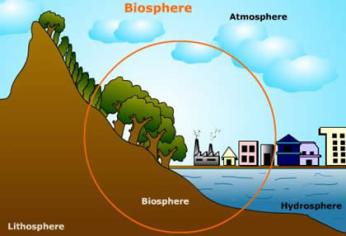Nature And Composition Of Biosphere – Geography Notes – For W.B.C.S. Examination.
বায়োস্ফিয়ারের প্রকৃতি এবং সংমিশ্রণ – ভূগোল নোট – WBCS পরীক্ষা।
Components 1. Hydrosphere:
It includes water in the oceans, lakes, ponds, etc., and covers about 73% area of the earth’s surface. Water is the major inorganic nutrient needed by all living organisms, hence, water is essential to all life. First life originated in water.Continue Reading Nature And Composition Of Biosphere – Geography Notes – For W.B.C.S. Examination.
The means of obtaining and conserving water have shaped the nature of terrestrial life; means of living within the water have the overwhelming influence on aquatic life. Water is one of the main agents in pedogenesis and is also the medium for several different ecosystems.
Water continuously circulates between atmosphere and the earth’s surface; this cycle is referred to as the water cycle. The energy for driving the cycle and, thus, ensuring a constant supply of fresh water on land comes from the sun. Solar heat evaporates water from the ocean which is the great reservoir of water.
A lesser amount of water is also evaporated from the surface of the land from plants, a process known as evapotranspiration. All this vaporized water forms clouds which moved by winds, may pass over land where they are cooled enough to precipitate the water as rain or snow. Some of the precipitated water soaks into ground, some runs off the surface into stream and goes directly back to the seas.
The ground water is returned to the surface by springs, by pumps and the transpiration—the movement of water in plants from roots to leaves. Water inevitably ends up back in the sea, but it may become incorporated into the bodies of several different organisms, one after another, en route.
Components 2. Atmosphere:
It is a thick gaseous mantle which envelopes the hydrosphere and earth’s surface, called the air. It supplies oxygen, nitrogen, carbon dioxide and other gases and is subjected to physical cycles by the sun and spin of earth. Cooled polar air sinks, while warm equatorial air rises and the axial rotation of the earth causes to shift air masses laterally resulting into the formation of global air currents.
The composition of atmosphere is somewhat uniform up-to a height of about 80 kms (Table 12.1). Higher levels have lighter gases. The atmosphere is denser near the earth and rarer away from the earth.
The atmospheric pressure is more near the earth than away from it. The atmosphere has a layer of ozone at a height of about 32-48 km; this layer acts as a barrier that checks ultraviolet rays of sun from reaching the earth which could be lethal for living organisms.
These constituents are highly variable.
Out of the various constituents of atmospheric gases, oxygen, nitrogen and carbon dioxide serve as metabolites for living organisms and, hence, they are essentially needed by them for their normal functioning. However, all these undergo characteristic cycles in nature in which organisms play an important role and, hence, their normal percentage atmosphere.
Components 3. Lithosphere:
The solid component of earth is called lithosphere. It is multilayered and includes following three main layers: crust, mantle and core (outer and inner). The core is the central fluid or vapourized sphere having diameter of about 2500 km from the centre and is possibly composed of nickel-iron. The mantle extends about 2900 km above the core. This is in a molten state.
The crust is the outermost solid zone of the earth and it is about 8 to 40 km above mantle. The crust is very complex and its surface is covered with the soil supporting rich and varied Cross section of earth showing different layers, biotic communities. The soil provides food, shelter, anchorage and concealment from predators to living organisms.
Besides being the source for the entry of nutrients and water in plants, the soil is the medium for the detritus food chain: nutrients released in detritus are decomposed by various soil microbes like bacteria, algae, fungi, protozoa, etc., bound in or on soil particles and taken back into plants through their roots.
Soil (mud) is also the main source of nutrients for all aquatic plants; rooted, submerged or free-floating. In addition, soil is the means to support for all terrestrial organisms: plants are anchored to the soil by their root systems; animals walk upon it and are supported by it, as many animals like nematodes, polychaetes, arachnids, insects, rodents, etc., live under the soil.
Our own publications are available at our webstore (click here).
For Guidance of WBCS (Exe.) Etc. Preliminary , Main Exam and Interview, Study Mat, Mock Test, Guided by WBCS Gr A Officers , Online and Classroom, Call 9674493673, or mail us at – mailus@wbcsmadeeasy.in
Visit our you tube channel WBCSMadeEasy™ You tube Channel
Please subscribe here to get all future updates on this post/page/category/website



 Toll Free 1800 572 9282
Toll Free 1800 572 9282  mailus@wbcsmadeeasy.in
mailus@wbcsmadeeasy.in


















































































































